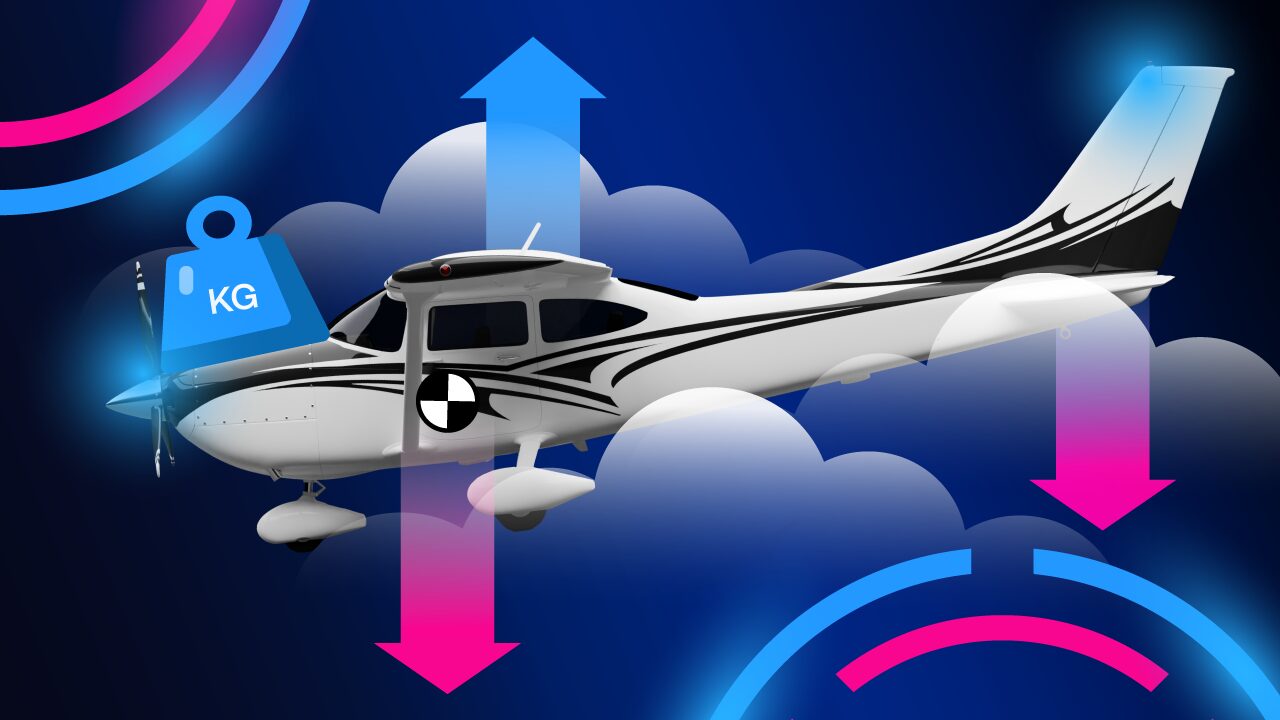-
Key Takeaways
-
What is Flight Following?
-
The Benefits of Flight Following
- Terrain and Obstacle Alerts
- Weather Advisories
- PIREPs
- Special Use Airspace
- Class B Clearance
- Limited Radar Vectors
- Emergency Services
- Practice Talking to ATC
-
How to Request Flight Following
- Required Equipment
- Where Can You Get Flight Following?
- On The Ground
- In The Air
-
What to Expect From ATC
- Phraseology
- Traffic Advisories
- Reporting Changes
- Asking for Help
- Handoffs and Cancellations
-
Canceling Flight Following
-
Flight Following Drawbacks
-
Flight Following Tips
-
Conclusion
Solo flying can quickly go from smooth to stressful.
Unexpected issues like engine trouble or bad weather make routine flights a handful. Suddenly, you’re busy flying the aircraft, looking for traffic, and plotting a diversion.
Instead of doing everything yourself, why not lean on ATC for support?
VFR flight following offers real-time help and improves situational awareness, all for free.
Don’t let the fear of talking with ATC deter you from using this important tool.
If you’re unclear about what flight following is or how to use it, this guide has you covered.
Key Takeaways
- VFR flight following offers real-time help and improves pilots’ situational awareness.
- With flight following, ATC provides traffic advisories and supplemental information.
- Benefits include enhanced safety, terrain alerts, weather advisories, and emergency assistance.
- Aircraft must have a radio and transponder to receive flight following.
What is Flight Following?
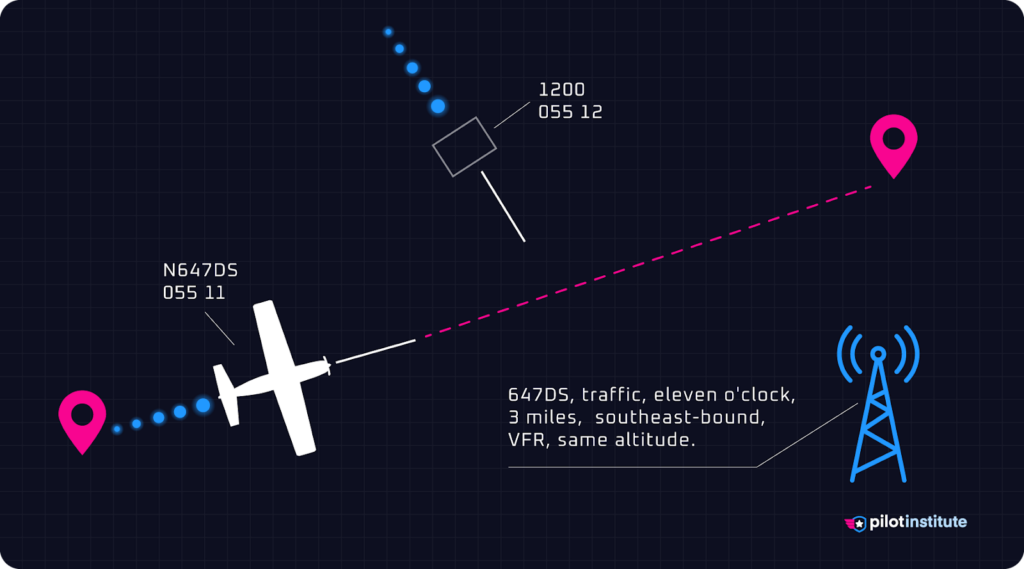
Flight following is a service provided by radar ATC facilities. ATC will advise pilots using flight following services of any other aircraft observed on the radar that will be in close proximity. This is to alert the pilot to the traffic, to be on the lookout for it, and to be in a better position to take action should the need arise.
This service does not relieve the pilot of the responsibility of scanning and avoiding traffic.
Flight following is a workload-permitting service provided by ATC. Controllers have the discretion to provide or continue to provide flight following. Many factors could prevent the controller from providing this service, such as:
- Radar Limitations
- Traffic Volume
- Controller Workload
- Frequency Congestion
The workload-permitting service makes flight following different from Instrument Flight Rule (IFR) flights. Traffic information is given to all aircraft on IFR flight plans unless the pilot refuses or is in Class A airspace.
Besides traffic advisories, flight following provides supplemental information that pilots can benefit from.
The Benefits of Flight Following
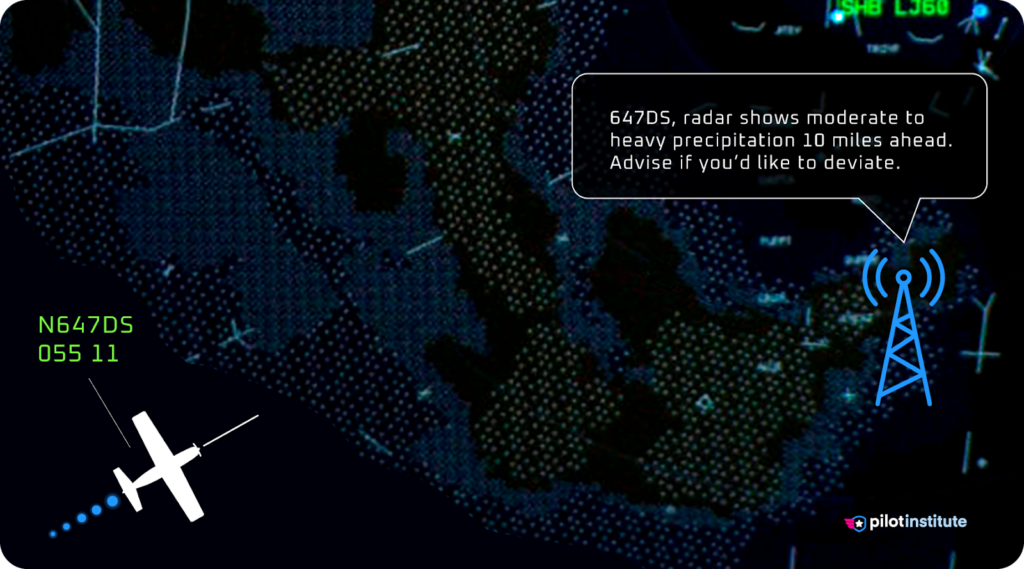
The primary benefits of flight following are enhanced safety and situational awareness.
While a good time to use flight following services is anytime, the best use cases are on cross-country flights and busy terminal airspace. Simply put, any situation where the pilot would like the added support or information is a good time to use flight following.
Besides traffic advisories, flight following services offer many more benefits. Let’s look at a few of them.
Terrain and Obstacle Alerts
ATC can issue a safety alert to pilots to aircraft in unsafe proximity to terrain, obstructions, or other aircraft. This service is contingent on the controller being aware of unsafe proximity.
Safety alerts are not compulsory, but they can be expected on a reasonable intermittent basis. Once the alert is issued, it is the pilot’s prerogative to determine what course of action to take. This procedure is intended for use in time-critical situations where aircraft safety is in question.
Weather Advisories
ATC has access to weather information and radar, providing advisory services to inform you of any significant weather.
PIREPs
Some weather information would have come from Pilot Reports (PIREPs), such as cloud bases and tops. Some other information that ATC could provide would be turbulence or icing that came from PIREPs.
Special Use Airspace
Flight following can advise pilots about Special Use Airspace (SUA). Military Operation Areas (MOAs) and restricted airspace are examples of airspaces that ATC can warn pilots about.
Class B Clearance
ATC clearance is required to enter Class B airspace. When talking to ATC on flight following, they can provide the necessary clearances to enter Class B airspace.
Limited Radar Vectors
VFR radar advisory service does not include vectors away from conflicting traffic unless requested by the pilot.
Emergency Services
Flight following is an excellent enhancement to safety for in-flight emergencies. During an in-flight emergency, the pilot has already established radio contact with ATC.
Practice Talking to ATC
Using flight following provides more exposure to talking to ATC, which is a great way to practice.
How to Request Flight Following

So now that you are interested in using flight following services, what must you do? Let’s look at the required equipment and the different ways you can request flight following services.
Required Equipment
To use flight following, aircraft must have a radio and transponder.
Depending on airspace, a Mode C transponder and ADS-B Out may be required. Radar used by ATC cannot display altitude information without Mode C transponders.
You can learn more about airspace requirements here.
Where Can You Get Flight Following?
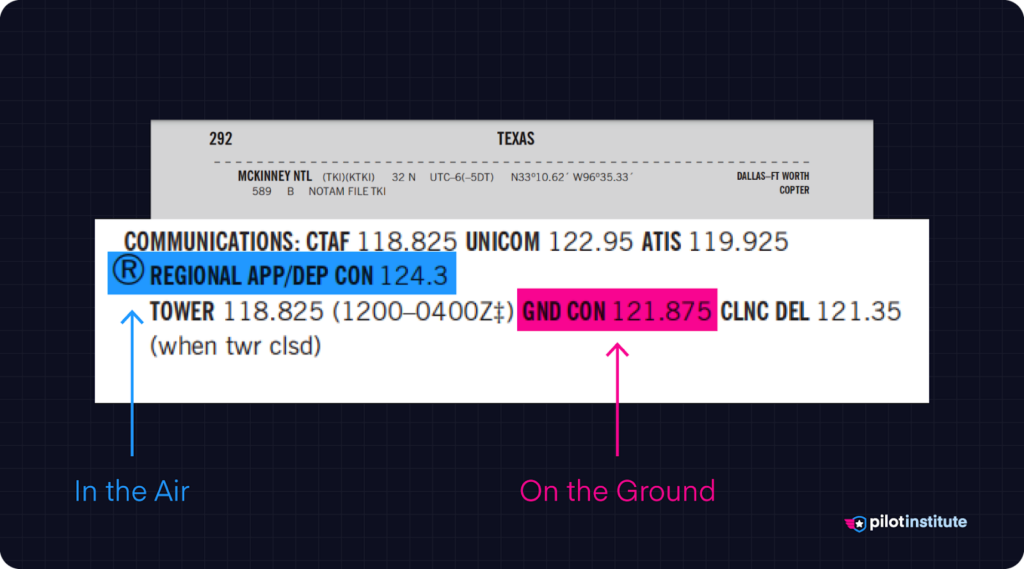
Flight following is provided wherever radar coverage is available.
If you recall your airspace classes, Class E airspace is controlled. You’ve probably flown many times in Class E airspace without talking to anyone, but ATC controls it.
You can check your sectional chart or chart supplement to find the radio frequency at which you can contact ATC. You can also access the frequencies using mobile Electronic Flight Bag (EFB) options such as Garmin Pilot or ForeFlight.
On The Ground
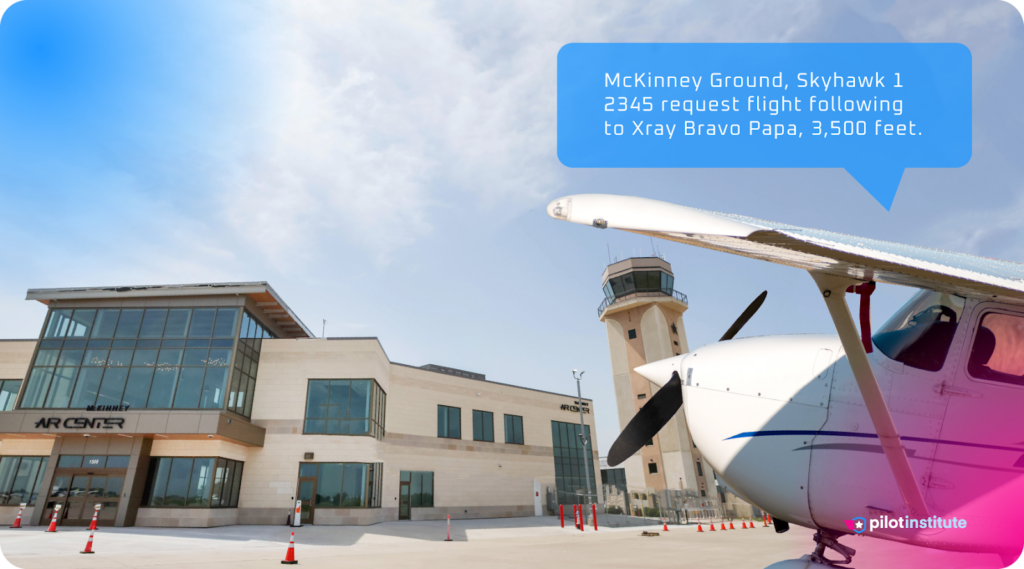
If you are flying out of a Class C or Class D airport, you can request flight following with the local ground control or clearance delivery. Controllers may tell you they cannot provide the service if the airspace is extremely busy.
Let’s use an example of a flight originating at McKinney Airport (KTKI) going to Bridgeport Municipal (KXBP).
Here is the exchange on McKinney Ground on 121.875.
You: “McKinney Ground, Skyhawk 12345 request flight following to Xray Bravo Papa, 3,500 feet.”
Xray Bravo Papa (XBP) is the FAA location identifier for Bridgeport Municipal. The altitude requested is based on your VFR cruising altitudes for the magnetic course.
McKinney Ground: “N345, after departure, contact Regional departure on 124.3, squawk 4545.”
You: “Cleared to Xray Bravo Papa, after departure contact Regional Departure on 124.3, squawk 4545.”
McKinney Ground: “N345 readback correct, report ready to taxi.”
You: “N345 is ready to taxi with information Alpha.”
This depends on whether you have received the Automatic Terminal Information Service (ATIS) and you are ready for taxi. If not, you can say you are not and can request to taxi anytime after.
In The Air

If you are already in the air, contact the Terminal Radar Approach Control (TRACON) or Air Route Traffic Control Centers (ARTCC) for flight following. These are referred to as “center” and “approach or departure” respectively.
The information can be found in sectional charts or on your mobile EFB to find the radio frequency for these controllers.
Let’s use an example of requesting flight following in the air.
You are flying from Mineral Wells Regional (KMWL) to Denton Enterprise (KDTO). This flight will be in the Dallas Fort Worth Class B airspace, which is very busy.
After taking off from Mineral Wells, you tune the radio to Fort Worth Center on 127.0, and the frequency is very busy with traffic. Because it is busy, you check in and just say “with request.” This allows the controller to continue with their workload with minimal interruption.
You: “Fort Worth Center, November 12345, VFR request.”
Fort Worth Center: “November 12345, say request.”
You: “November 12345 is a Cessna Skyhawk, 4 miles northeast of Mineral Wells, 3,500 feet, request flight following to Delta Tango Oscar.”
Delta Tango Oscar (DTO) is the FAA location identifier for Denton Enterprise.
Fort Worth Center: “N345, squawk 5454, and ident.”
Squawk is the unique four-digit code you must set on your transponder. Ident is a function on your transponder that makes your radar target on the radar controller’s screen flash to help locate you on their screen.
You: “Squawk 5454 and ident, N345.”
Fort Worth Center: “N345, radar contact 4 miles North East of Mineral Wells at 3,500.”
What to Expect From ATC
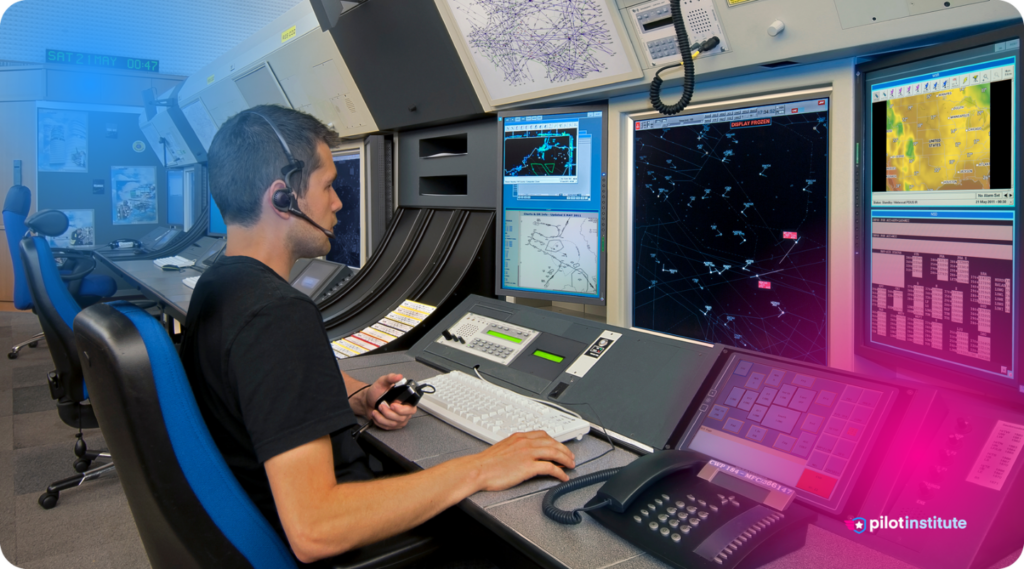
Phraseology
You will need to know particular ATC phraseology when using flight following.
Using the correct phraseology in response to ATC’s instructions is essential. Do not add to the controller’s workload by not having the proper phraseology.
Remember, flight following is a workload-permitting service by ATC.
Traffic Advisories
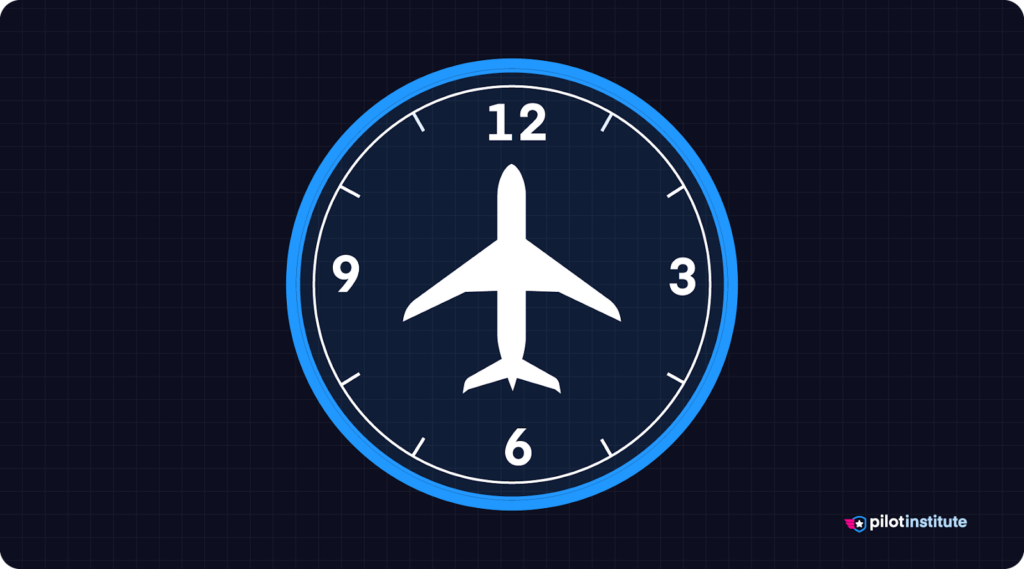
An example of ATC phraseology is the traffic advisory service that flight following provides.
ATC is only able to see your ground track, not your heading. Using this ground track, ATC provides the location of other traffic’s azimuth relative to you using the “o’clock” method.
This system uses the concept of the clock face to provide a reference point.
Using the aircraft as the center of a clock, with its nose pointing straight up at 12 o’clock, each number on the clock represents a relative direction.
Here are the four main directions using the o’clock method.
- 12 o’clock: Directly Ahead
- 3 o’clock: To the Right
- 6 o’clock: Directly Behind
- 9 o’clock: To the Left
Controllers can quickly convey the relative positions of other traffic using the clock positions. For example, if ATC tells you about traffic at 1 o’clock, the traffic will be ahead and slightly to your right.
Now that ATC has provided you with the traffic advisory, your response should be whether you have the traffic in sight. This can be as simple as “traffic in sight” or “negative traffic” to acknowledge the traffic advisory.
Reporting Changes
Remember how you provided the cruising altitude and destination when requesting flight following? Are you then forced to stick with that plan?
Flight plans are dynamic in nature, requiring changes due to weather or unexpected fuel burn.
With any change in plans, be it altitude, destination, or route changes, keep ATC informed of such changes.
Asking for Help
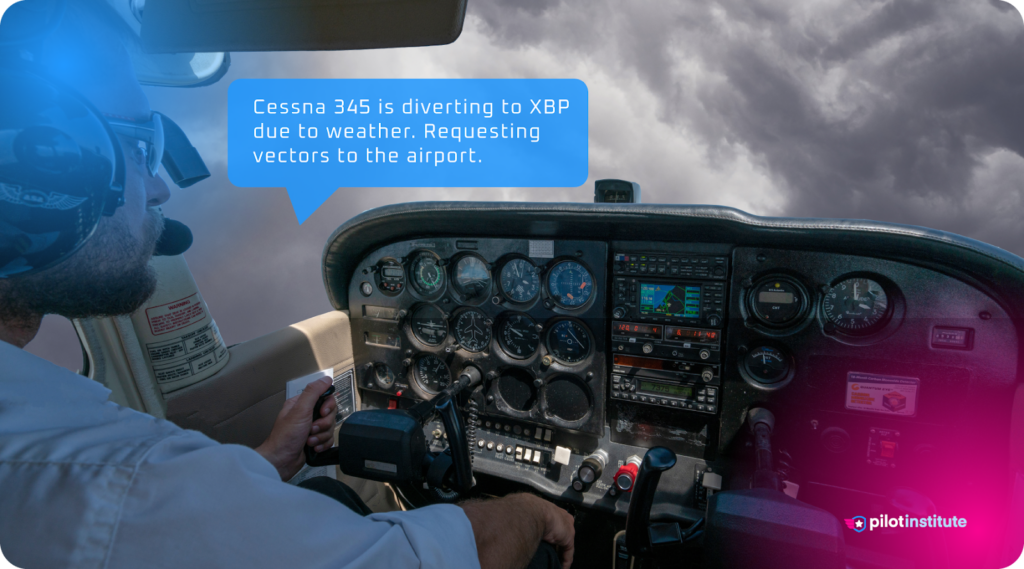
As mentioned earlier, flight following enhances safety and situational awareness. Using ATC as a resource for help can come in different forms.
Workload permitting, you can ask ATC for advice on weather developments or how much traffic is at your destination airport.
During an in-flight emergency, they are especially useful for giving you directions to the nearest airport. By declaring an emergency with ATC, the controller can vector you to the nearest airport and clear as much traffic as possible.
This is faster and more efficient than having to broadcast on the emergency guard frequency.
Handoffs and Cancellations
When flying on longer cross-country flights, you would traverse multiple ATC facilities. ATC will pass you to the next sector’s ATC frequency to contact when using flight following. This is commonly referred to as “handoff” to the next controller.
After being handed off to the next controller, you would simply check in with your identification and altitude.
While you have been given a new radio frequency, keeping track of previous frequencies is important. This is because you might not be able to establish radio contact with the frequency you have been handed off to.
You can try multiple times to establish two-way radio communications. If unable, you can return to the previous frequency to let ATC know you could not contact the next frequency.
On long cross-country flights, you can cancel flight following and pick it up later with another controller.
Canceling Flight Following
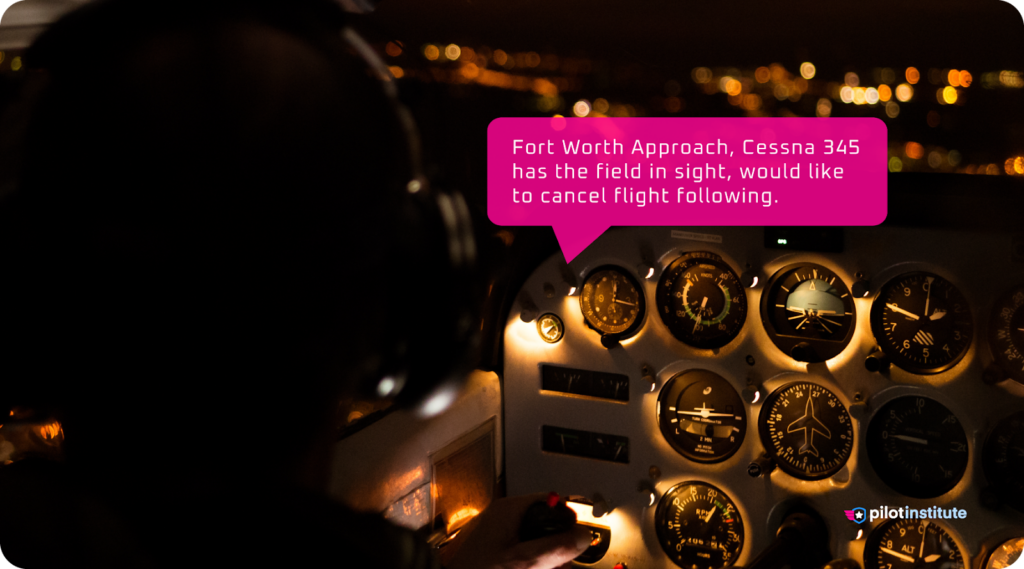
You can also cancel flight following when you have the destination in sight or whenever you feel it necessary.
Here is an example of canceling flight following with the destination in sight:
“Regional Approach, November 12345 has the field in sight. Would like to cancel flight following.”
ATC will try to inform you of any traffic they can see in the area and ask that you change your squawk code back to 1200. This is also confirmed when they say flight following is canceled.
You should never just tune off the ATC frequency and not notify ATC that you are canceling flight following. This can lead to ATC activating emergency services to find you.
Flight Following Drawbacks
While flight following is a great service and should be used as much as possible, there are some drawbacks.
Flight following requires ATC to have radar coverage of the airspace. In some areas, that may not be possible. These “blind areas” means flight following services will not be provided.
Flight following being workload-permitting will also mean that ATC may drop your flight following when they get too busy. Not only does it mean that you will not get flight following services, but the airspace is very crowded if controllers are too busy. Pilots should exercise extreme caution and vigilance when in congested airspace.
If you cannot receive flight following, filing and opening a flight plan is an alternative.
A flight plan does not provide traffic advisory services or require that you remain in communication with ATC. However, it offers oversight from an external agency other than anyone the pilot told of their flight plan.
The pilot must ensure that the flight plan is closed upon arrival at their destination. If the pilot does not, ATC will activate search and rescue services 30 minutes after the filed estimated arrival time. This service allows pilots not using flight following a chance at being rescued should the need arise.
A flight plan is also a good backup to flight following, and can be done concurrently.
Flight Following Tips
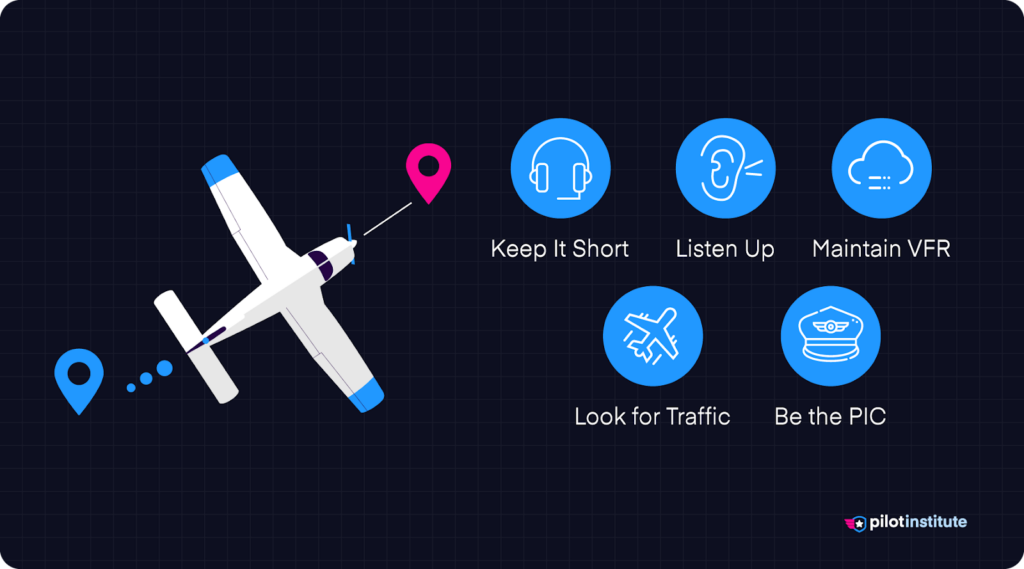
Here are some flight following tips:
- Know your radio phraseology, you can study the Pilot/Controller Glossary to know the phraseology.
- Think before you speak to keep transmissions short. Having the applicable flight plan information at the ready helps. (Airport identification code, requested altitude, course heading, etc.)
- Practice radio calls. When you’re not in the airplane, practice talking to ATC with our Radio Communications Made Easy course.
- Listen for your identification. Take flight following seriously, and don’t complicate the controller’s job.
- Be the Pilot in Command (PIC). Don’t let ATC vector you into clouds or rely on ATC for navigation. Your responsibility remains to fly in Visual Flight Rules and with proper preflight planning.
- The responsibility to see and avoid traffic remains your responsibility, do not depend only on ATC to provide traffic alerts.
- Get a preflight weather briefing. Don’t rely on ATC for weather advisory and avoidance.
- Don’t be afraid to ask for help, you can request what you want.
- ATC likes it when VFR pilots use flight following, as you are in contact with them. This makes it easier to separate traffic from all aircraft in the controlled airspace.
- Monitor the emergency frequency, 121.5, to render assistance to other aircraft. ATC will use the emergency frequency as a last resort to contact you if communications with the primary frequency fail.
Conclusion
While flight following may be intimidating, the invaluable support enhances your safety. Having an extra set of eyes to monitor the progress of your flight and to be able to provide real-time advisory can increase your confidence.
The supplementary information also allows better decision-making in ever-changing flight conditions. Should you experience an emergency, the immediate help that ATC can provide is also much better.
Embracing flight following enhances individual safety and contributes to overall airspace efficiency. So, next time you take to the skies, consider enlisting the support of flight following—it’s a decision that could make all the difference.

